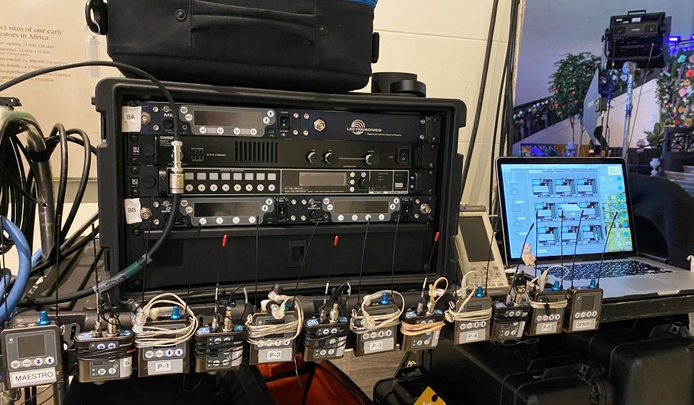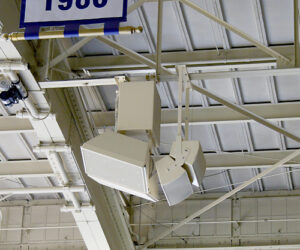Things in RF world have thankfully settled down following years of uncertainty and change. The bottom line at present: the remaining usable frequency spectrum for wireless systems in the U.S. is 470 to 608 MHz (UHF channels 14-36), joined by 174 to 216 MHz (VHF channels 7-13) along with additional bands that we’ll mention a bit later.
The corporations that acquired spectrum from 614 to 698 MHz have been commencing services across the country. As a result, it’s long past time for wireless users to put alternative arrangements into place for all equipment operating above 608 MHz, and fortunately, all reputable wireless manufacturers have been planning for this eventuality by designing systems with wide tuning ranges, flexible operation, and good receiver filtering. Many transmitters also offer user-selectable RF power that can be quite helpful in tailoring for high-channel-count and short-distance applications.
A lot of work has gone into efficiently using the available spectrum, so that more wireless system channels can work together without interference within a particular 6 MHz television channel or other patch of available spectrum. Key to this spectral efficiency is digital transmission of the signal between the transmitter and receiver, as digital systems can be designed to offer important tradeoffs such as range, channel density and audio fidelity.
Further, more manufacturers now offer a range of options in the VHF bands, and there are also systems available in alternate bands, including 1.8 GHz, 2.4 GHz, 5 GHz, 6 GHz, and other bands as well. In general, these alternative bands are best used for specialized purposes because higher frequencies don’t have the same propagation characteristics as the VHF and lower UHF bands.
The introduction of digital wireless has also coincided with a push toward digital audio networking and computer control within the audio equipment chain. Touring-class wireless is likely to have the ability to be remotely monitored and controlled, and with integrated AES/EBU or (Audinate) Dante, receiver outputs can offer the option of keeping the signal in the digital domain from the stage through the console to the loudspeaker system.
Some systems have also added technologies for increasing reliability and resistance to dropouts, transmitting the same signal on more than one frequency (frequency diversity) and transmitting the same audio data in different time slots (time diversity), with algorithms at the receiver reassembling the digital information into coherent order.
Because the emitted signal from the transmitter is digital and the source audio has been converted to data, the audio can be encrypted before it is sent – and therefore protected from being monitored by anything other than its assigned receiver. Security is now readily available for applications that require it. Encryption at levels of 128-bit and 256-bit is common, and at least one system has upped the ante to 512-bit encryption.
Attention has also been directed toward placing antennas closer to the performing area where the transmitters are in use. Some of the available antenna systems are active, boosting the received signal level before it travels to the receiver via coax cable. Directional antennas accomplish double duty, with increased sensitivity aimed toward the desired signals and lower sensitivity at the rear to attenuate interfering RF signals within their null zones.
Several manufacturers also offer very good, and constantly updated, software packages that help to manage and monitor wireless system performance over a network, from pre-show planning through post-performance analysis. With all of this in mind, the systems presented here in our roundup are more powerful and flexible than ever before.
ENHANCED LISTING

Lectrosonics D Squared
lectrosonics.com
The D Squared digital wireless microphone system from Lectrosonics utilizes 4th-generation digital architecture for excellent flexibility, ultra-fast setup, studio quality audio, and ultra-low latency. The system includes the DSQD 4-channel digital receiver, DBSM, DBSMD, and DBu digital belt pack transmitters, DHu digital handheld transmitter, and DPR-A digital plug-on transmitter. Features include 24-bit, 48 kHz digital audio, 2-way IR sync, four levels of encryption, and a tuning range of 470-608 MHz (470-614 MHz for export versions).
The DSQD receiver is a four-channel, half-rack design with analog and Dante digital outputs and is compatible with the latest digital transmitters, and backward compatible with Digital Hybrid Wireless transmitters. Three different diversity schemes are available, including antenna switching, Vector Diversity, and Frequency Diversity. The transmitters offer RF power selections at 10, 25 and 50 mW and include AES 256-CTR encryption for high level security applications. The DBSM and DBSMD transmitters also offer HDM High Density mode for ultra-tight channel spacing.
TECHNOLOGY FOCUS: A headphone jack is included on the DSQD for audio monitoring per channel. Ethernet and USB ports allow the receiver to connect to Wireless Designer software for setup, frequency coordination, and monitoring, and a serial port enables connection between receivers.
OF NOTE: Antenna bias power can be engaged in the menu, and front panel LEDs show the status. Each DSQD ships with half the rack hardware needed to mount two units together, yielding 8 channels in 1RU.

KEY SPECS
RF Transmission: Digital
Frequency Band: UHF (470 – 608 MHz for U.S.;
470 – 614 MHz for export)
Receiver Bandwidth: 144 MHz
Frequency Agility/RF Search: Automatic
discovery & channel selection
Diversity Scheme: Noiseless antenna switching, Vector, or Frequency
Receiver Format: 4 channels in ½ RU
Receiver Outputs: Dante & analog
Audio Bandwidth: 20 Hz – 20 kHz (+/-1 dB)
Sampling Rate: 24-bit/48 kHz
Latency: Ranges from 1.2 ms in D2 mode to 2.9 ms in Hybrid compat modes
Transmitter RF Power: Variable; 10/25/50 mW
Tx/Rx Communication: Via infrared
Control/Interfacing: USB, and RJ-45 Ethernet ports; monitor and control with Wireless Designer software
STANDARD LISTINGS
MIPRO ACT-5800 Series
mipro.com.tw, avlex.com

RF Transmission: Digital
Frequency Band: 5.8 GHz
Receiver Bandwidth: 125 MHz (5,725 – 5,850 MHz)
Frequency Agility/RF Search: Manually
Diversity Scheme: Dual-tuner true diversity receiving
Receiver Format: Quad channel (1 RU)
Receiver Outputs: Analog
Audio Bandwidth: 18 Hz – 23 kHz
Sampling Rate: 24-bit/48 kHz
Latency: < 1.7 ms
Transmitter RF Power: 20 mW for both handheld and bodypack (country dependent)
Tx/Rx Communication: ACT Sync
Sennheiser Digital 6000
sennheiser.com
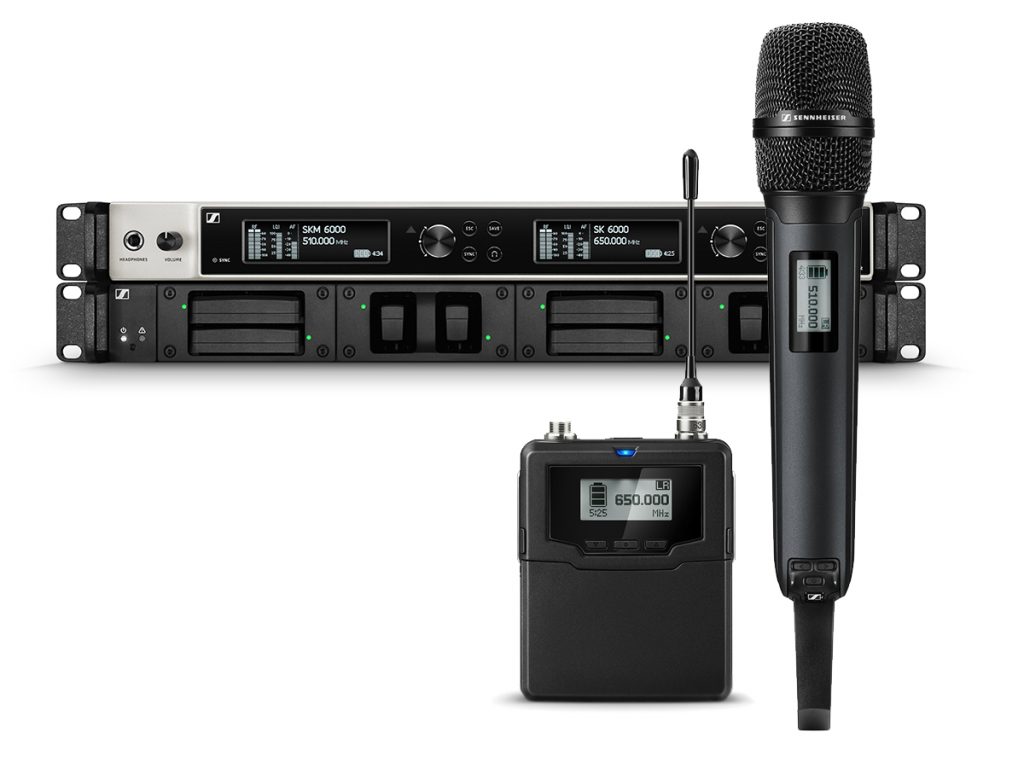
RF Transmission: Digital
Frequency Band: 470 – 714 MHz
Switching Bandwidth: 88 MHz
Frequency Agility/RF Search: PLEASE PROVIDE
Diversity Scheme: Dual-tuner true diversity
Receiver Format: Dual channel (1 RU)
Receiver Outputs: Analog and digital (optional Dante)
Audio Bandwidth: 30 Hz – 20 kHz
Sampling Rate: 24-bit/48 kHz or 96 kHz
Latency: 3 ms
Transmitter RF Power: 25 mW rms, 50 mW peak
Tx/Rx Communication: PLEASE PROVIDE
Shure SLX-D
shure.com
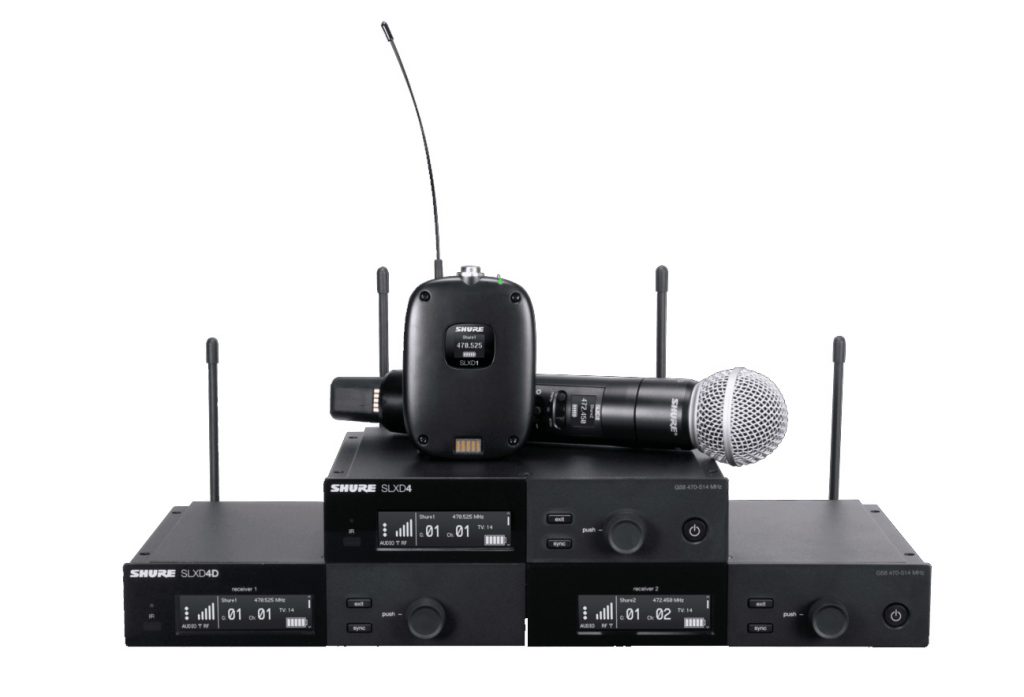
RF Transmission: Digital
Frequency Band: 470 – 937.5 MHz (numerous bands, region dependent)
Tuning Range: 44 MHz
Frequency Agility/RF Search: Intelligent scanning automatically finds and deploys cleanest frequencies to the networked receivers; transmitters receive frequencies via IR sync with the receivers
Diversity Scheme: Digital predictive switching diversity
Receiver Format: Single and dual channels
Receiver Outputs: Analog (1/4-inch and XLR)
Audio Bandwidth: 20 Hz – 20 kHz
Sampling Rate: 24-bit/48 kHz
Latency: < 3.2 ms
Transmitter RF Power: 1 mW and
10 mW
Tx/Rx Communication: IR sync
Audio-Technica 3000 Series (Fourth Generation)
audio-technica.com
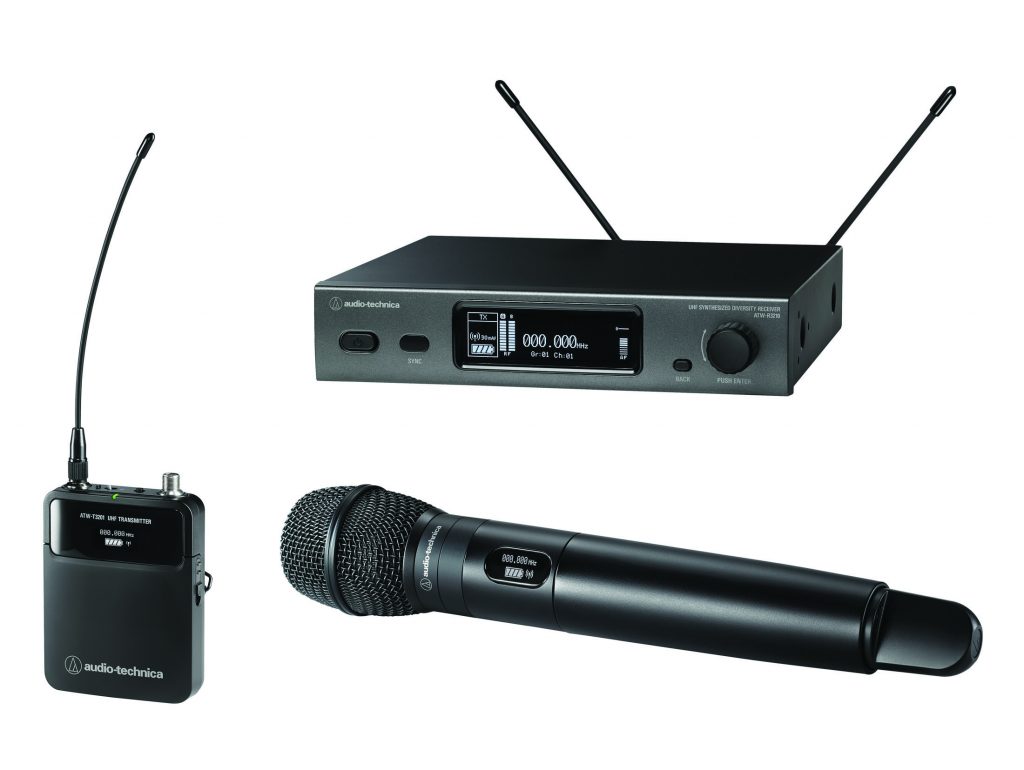
RF Transmission: Analog
Frequency Band: 470 – 530 MHz and 530 – 590 MHz
Receiver Bandwidth: 25 MHz (minimum)
Frequency Agility/RF Search: Auto scan and sync
Diversity Scheme: Dual-conversion true diversity
Receiver Format: 1/2RU 1-channel
Receiver Outputs: Analog (balanced XLR; unbalanced 1/4-inch)
Audio Bandwidth: 25 Hz–16.7 kHz (with handheld transmitter)
Transmitter RF Power: 10/30 mW
Tx/Rx Communication: Pilot tone
Of Note: Multifunction button on transmitters can be used to switch to backup frequency; dual-mode receiver display can switch between standard view or performance view that highlights key metering; handheld transmitter works with six interchangeable A-T mic capsules and other compatible capsules.
Audix Performance Series
audixusa.com
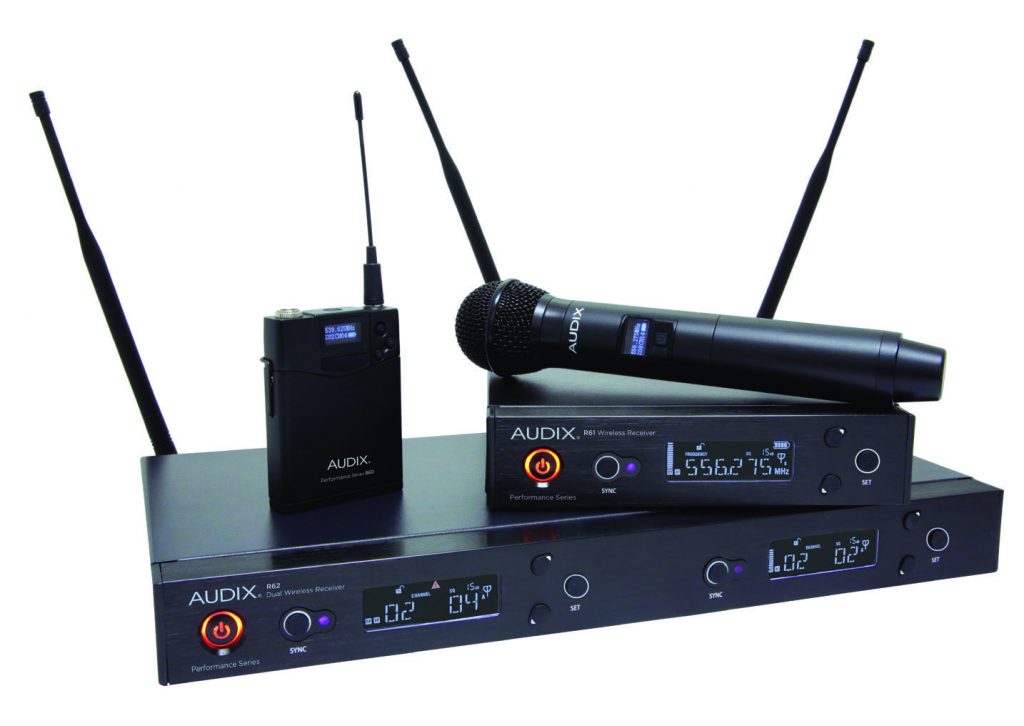
RF Transmission: Analog
Frequency Band: UHF, 522 MHz – 586 MHz (R61/62 receivers)
Receiver Bandwidth: 64 MHz (R61/62)
Frequency Agility/RF Search: Auto scan and sync of 207 pre-coordinated frequencies
Diversity Scheme: Dual tuner, true diversity
Receiver Format: 1/2RU 1-channel, 1RU 2-channel
Receiver Outputs: Analog (XLR & 1/4-inch)
Audio Bandwidth: 45 Hz – 18 kHz
Sampling Rate: N/A
Transmitter RF Power: Variable, 10 and 40 mW
Tx/Rx Communication: Pilot tone
Control/Interfacing: N/A
Of Note: Modular interchangeable capsules for OM Series and VX5 vocal mics with HH; 16 systems (conservatively) can be used simultaneously; 2,560 individual frequencies available for manual tuning.
Electro-Voice RE3
electrovoice.com
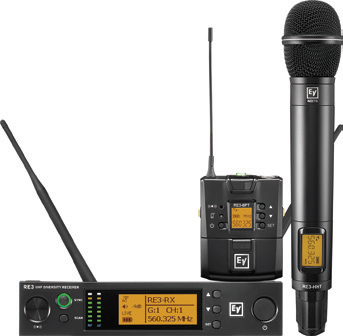
RF Transmission: Analog
Frequency Band: UHF (488 – 524 MHz, 560 – 596 MHz, other bands available including 653 – 663 duplex gap)
Receiver Bandwidth: 36 MHz (1,400 selectable frequencies) for 488 – 524 MHz and 560-590 MHz
Frequency Agility/RF Search: Frequency scan & sync
Diversity Scheme: True diversity
Receiver Format: Half-rack/1-channel
Receiver Outputs: Analog
Audio Bandwidth: 51 Hz – 16 kHz (handheld); 63 Hz – 16 kHz (bodypack, both +/-2 dB)
Transmitter RF Power: Variable, 10/50 mW
Of Note: Operates on three bandwidths for the North American market, including two 36 MHz-wide bands in the low and high 500 MHz spectrum as well as one strategically chosen to operate within the 600 MHz duplex gap.



